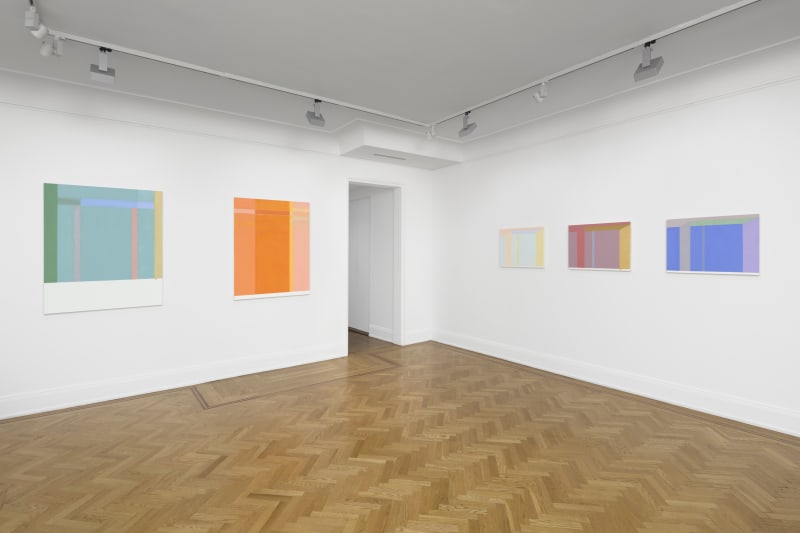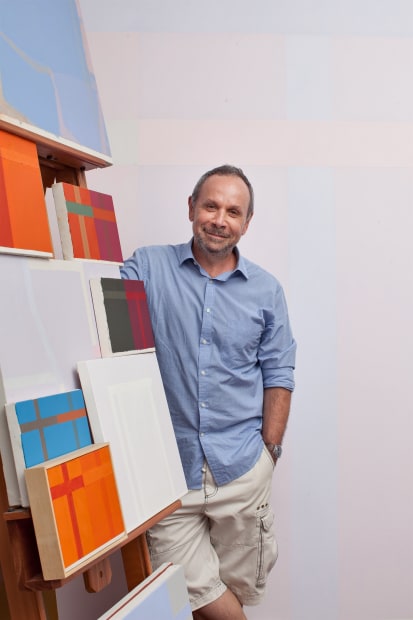PAULO PASTA: passages
-
Overview
David Nolan Gallery is delighted to announce passages, a solo exhibition of paintings by Paulo Pasta (b. 1959), marking the artist’s second solo presentation in New York City. Looked upon as one of Brazil’s most influential and beloved painters, Paulo Pasta moves easily between pure abstraction and landscape art. His work evokes architectural space, landscapes both urban and pastoral, memory, and perception through a rigorous yet poetic language of geometry, color, and light. His paintings live in a space that is physical, emotional, and suggestive of worlds beyond ours.
Whether in the form of small “pocket paintings” or large-scale canvases, Pasta’s works are elegant, compositionally self-assured, and tonally resonant. For years, Pasta has maintained a private practice of painting landscapes which carry a sense of ambiguity and obscurity, bordering on abstraction. His more purely abstract works recall urban silhouettes, interior spaces, and metaphysical atmospheres - drawing inspiration from the light and palette of São Paulo, where he lives and works with a kind of monastic discipline.
The chromatic variations in his paintings, often veil-like and atmospheric, have much in common with Morandi’s chalky paintings, while the use of shape and space brings to mind Ellsworth Kelly and the architectural gravitas of Luis Barragán. A focus on light as an element is also something that unites Barragán and Pasta - even the particularly flat paintings seem to retain and emit light. The presence of space and light in his work carry the contemplative quality of Piero della Francesca, while the architectural allusions are also reminiscent of Brice Marden. ‘Thresholds’ in Pasta’s work is evocative of ‘zips’ in Barnett Newman’s paintings which Newman stresses aren’t merely lines or stripes but living structural elements, infused with sublime energy, that simultaneously separate and hold together the color field. Pulsating colors in Pasta’s work recall Rothko’s color field paintings. While Rothko and Bonnard are two of his proclaimed favorite artists, Paulo Pasta creates work that stands solitary and are unmistakably his own. Unlike the contained planes of Mondrian, Pasta’s paintings are quiet, and generous, offering us not a depiction of a place, but the feeling of spaciousness.
As the art critic Lorenzo Mammi describes Pasta’s paintings, “They are certainly agreeable (the colours almost always gentle, the construction balanced), but by no means submissive. On the contrary, they display a certain buoyant self-sufficiency, an accommodation which rather than pushing us away, welcomes us in.”
The exhibition’s title, passages, suggests both movement and interiority. It also suggests the transference of something - such as information, or, in this case perhaps a vision or a memory a la Proust’s madelaine. Perhaps the passage we are seeing is not on the canvas, but through it, from the artist’s memory to ours. This points to an important quality in Pasta’s work: the capacity of painting to suspend time, to occupy the liminal space between memory and perception. His paintings speak to an experience that is neither purely sensory nor purely intellectual, but something in between. This intermediary experience has been described by Pasta as “the noise of something.” He elaborates on this concept by explaining: “I really want my painting to be a memory of the world, to have the rumour of things.”
Geometric forms in Pasta’s paintings recall beams, columns, and doorframes to suggest thresholds and interiors once seen or imagined. Much like in an orchestra, color functions in his work as musical timbre, quietly guiding spatial relationships and emotional resonance, at once breaking up the space and joining it together. A red may feel closer, more intimate and denser than a blue, not only visually, but experientially. Pasta’s palette is vast and not formulaic, and yet they are all characteristically his. Though his surfaces appear smooth and minimal, they are in fact the result of complex chromatic layering, built up with hand-mixed oil paints to achieve precise tones. In certain areas, the paint accumulates into a visible relief, adding further dimensionality to the canvas. Minor imperfections along the thresholds appear exaggerated – they add visual charm and humanize the works.
To complement the newer paintings, the exhibition includes recent drawings: paintings on paper that are looser, more gestural, and subjective in tone. These pieces mark a new phase in the artist’s practice. The measured restraint of earlier work has given way to something more immediate and painterly. Line and color embark on less certain paths, and the boundaries become more fluid. Pasta’s paintings on canvas hold a kind of stillness, while his works on paper introduce movement and signal a shift towards greater spontaneity.
“If we had to find an ancient archetype, then it would be in the painting of ruins, which describe how human constructions gradually return to nature, by consumption more than dramatic events. And, while we are in the mode of analogies, I would say that the recent large scale ‘polyphonic’ paintings are kin of the Renaissance sacra conversazione: altarpieces in which various characters share the same space, but do not interact with one another, all are turned to the viewer. This is clearly a game, but it serves to remind us, once again, that Pasta’s painting is imbued with art history and literature and that reduction to the simple, which is one of its main ambitions, does not hide complex affiliations.” — Lorenzo Mammi, “What does a painting serve for?”, 2024
— Tharini Sankarasubramanian
-
Installation Views
-
Lucas Arruda reflecting on Paulo Pasta's practice as he experienced it when working as his studio assistant
As hard as I try, I doubt I could ever fully convey the colors, the rhythm, the small rituals—in short, the rich and singular universe of Paulo’s studio. When I search for words to define this world, I think of tenderness, kindness, delicacy... But I also think of solitude, construction, pursuit, existentialism.
The tonal subtlety, the carefully built colors—so characteristic of Paulo’s paintings—are deeply connected to the atmosphere that pervades his studio. I remember the little piece of chocolate he would eat before beginning to paint, the radio playing classical music, the brief nap, the stack of books always within reach, the way he would cover and rework the canvas until he found the exact tone. And surrounding it all, a certain melancholy—the melancholy of the painter’s solitary craft, of an endless search for something that may never be fully attained.
I also remember how he would always pause to think before speaking, the gentleness in his conversations, in the way he taught, and in how poetry revealed itself through painting.
More than painting techniques, I learned from him a way of thinking about art, of seeing it from the inside out. The greatest lesson Paulo taught me was the importance of being honest with one’s own work. At its core, it is about making decisions that stem from oneself—with absolute sincerity toward what one sees and feels.
(“Paulo Pasta, Viagem ao redor do meu quarto [A journey around my room], São Paulo: Almeida & Dale, 2025)
-
Works
-
![Paulo Pasta Il Padrino [The Godfather], 2025 oil on canvas 39 3/8 x 47 1/4 in (100 x 120 cm)](data:image/gif;base64,R0lGODlhAQABAIAAAAAAAP///yH5BAEAAAAALAAAAAABAAEAAAIBRAA7) Paulo PastaIl Padrino [The Godfather], 2025oil on canvas39 3/8 x 47 1/4 in (100 x 120 cm)
Paulo PastaIl Padrino [The Godfather], 2025oil on canvas39 3/8 x 47 1/4 in (100 x 120 cm) -
 Paulo PastaUntitled, 2024oil on canvas47 1/4 x 39 3/8 in (120 x 100 cm)
Paulo PastaUntitled, 2024oil on canvas47 1/4 x 39 3/8 in (120 x 100 cm) -
 Paulo PastaUntitled, 2025oil on canvas47 1/4 x 39 3/8 in (120 x 100 cm)
Paulo PastaUntitled, 2025oil on canvas47 1/4 x 39 3/8 in (120 x 100 cm) -
 Paulo PastaDuccio I, 2025oil on canvas19 3/4 x 27 1/2 in (50 x 70 cm)
Paulo PastaDuccio I, 2025oil on canvas19 3/4 x 27 1/2 in (50 x 70 cm) -
 Paulo PastaDuccio II, 2025oil on canvas19 3/4 x 27 1/2 in (50 x 70 cm)
Paulo PastaDuccio II, 2025oil on canvas19 3/4 x 27 1/2 in (50 x 70 cm) -
 Paulo PastaDuccio III, 2025oil on canvas19 3/4 x 27 1/2 in (50 x 70 cm)
Paulo PastaDuccio III, 2025oil on canvas19 3/4 x 27 1/2 in (50 x 70 cm) -
 Paulo PastaUntitled, 2022oil on canvas31 1/2 x 35 3/8 in (80 x 90 cm)
Paulo PastaUntitled, 2022oil on canvas31 1/2 x 35 3/8 in (80 x 90 cm) -
 Paulo PastaUntitled, 2022oil on canvas66 7/8 x 51 1/8 in (170 x 130 cm)
Paulo PastaUntitled, 2022oil on canvas66 7/8 x 51 1/8 in (170 x 130 cm) -
 Paulo PastaUntitled, 2023oil on canvas47 x 39 1/2 in (120 x 100 cm)
Paulo PastaUntitled, 2023oil on canvas47 x 39 1/2 in (120 x 100 cm) -
 Paulo PastaUntitled, 2023oil on canvas86 1/2 x 71 in (220 x 180 cm)
Paulo PastaUntitled, 2023oil on canvas86 1/2 x 71 in (220 x 180 cm) -
 Paulo PastaUntitled, 2017oil on canvas7 1/8 x 9 1/2 in (18 x 24 cm)
Paulo PastaUntitled, 2017oil on canvas7 1/8 x 9 1/2 in (18 x 24 cm) -
 Paulo PastaUntitled, 2023oil on canvas4 x 5 7/8 in (10.2 x 14.9 cm)
Paulo PastaUntitled, 2023oil on canvas4 x 5 7/8 in (10.2 x 14.9 cm) -
 Paulo PastaUntitled, 2023oil on canvas47 1/4 x 39 3/8 in (120 x 100 cm)
Paulo PastaUntitled, 2023oil on canvas47 1/4 x 39 3/8 in (120 x 100 cm) -
 Paulo PastaUntitled, 2025oil on canvas47 1/4 x 39 3/8 in (120 x 100 cm)
Paulo PastaUntitled, 2025oil on canvas47 1/4 x 39 3/8 in (120 x 100 cm) -
 Paulo PastaUntitled, 2024oil on canvas7 1/8 x 9 1/2 in (18 x 24 cm)
Paulo PastaUntitled, 2024oil on canvas7 1/8 x 9 1/2 in (18 x 24 cm) -
 Paulo PastaUntitled, 2022oil on canvas11 3/4 x 15 3/4 in (30 x 40 cm)
Paulo PastaUntitled, 2022oil on canvas11 3/4 x 15 3/4 in (30 x 40 cm) -
 Paulo PastaUntitled, 2024-25oil on paper29 7/8 x 22 7/8 in (76 x 58 cm)
Paulo PastaUntitled, 2024-25oil on paper29 7/8 x 22 7/8 in (76 x 58 cm) -
 Paulo PastaUntitled, 2024-25oil on paper29 7/8 x 22 7/8 in (76 x 58 cm)
Paulo PastaUntitled, 2024-25oil on paper29 7/8 x 22 7/8 in (76 x 58 cm)
framed: 32 1/4 x 25 1/4 in (81.9 x 64.1 cm)
-
-
PRESS
-
Brazilian Artist Paulo Pasta’s Quiet, Lyrical Abstractions Alight in New York
Artnet News September 30, 2025At David Nolan Gallery, Pasta's new and recent works expand upon his explorations into shape, color, and scale. An influential figure within the development of contemporary Brazilian painting, Paulo Pasta... -
‘Now I’m on the Stage’: 7 Artists on Their Museum Residencies in Harlem
Seph Rodney · The New York Times November 14, 2025The Studio Museum in Harlem’s longtime residency program has been pivotal to artists of color. Here, alumni look back on why it was so crucial to them. The Studio Museum...
-
-
ABOUT THE ARTIST

-
Artist


![Paulo Pasta Il Padrino [The Godfather], 2025 oil on canvas 39 3/8 x 47 1/4 in (100 x 120 cm)](https://artlogic-res.cloudinary.com/w_600,c_limit,f_auto,fl_lossy,q_auto/artlogicstorage/davidnolangallery/images/view/15aa83fb7fae02d694ef3af2f8577479j/davidnolangallery-paulo-pasta-il-padrino-the-godfather-2025.jpg)



















